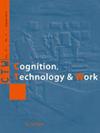Prevalence and pattern of work-related musculoskeletal disorders among nigerian bricklayers.
IF 3.4
3区 工程技术
Q2 ENGINEERING, INDUSTRIAL
引用次数: 0
Abstract
BACKGROUND Typically, bricklayers in developing countries' contexts manually lay bricks, concrete blocks and other similar materials to construct walls and buildings which make them susceptible to work-related musculoskeletal disorders (WRMSDs). The burden of WRMSDs among this high-risk group seems has not been well documented. OBJECTIVES This study examined the prevalence of WRMSDs among bricklayers in Nigeria. METHODS A cross-sectional survey of 118 consenting bricklayers from a Nigerian setting was carried out. The standardized Nordic musculoskeletal disorder questionnaire and a proforma were used to profile the prevalence of WRMSDs and socio-demographic information of the respondents. Data was analyzed using descriptive and inferential statistics. Alpha level was set at p < 0.05. RESULTS The 12-months and 7-days prevalence of WRMSDs were 87.3% and 67.4% . Shoulder (61.0%) and the low-back (59.3%) were the two most affected anatomical sites based on 12-month prevalence. WRMSDs affecting the knees (6.8%) was the most disabling in carrying normal work routines. Working for less than 10 years was significantly associated with high prevalence of WRMSDs in the shoulder (odd ratio (OR) = 0.27, 95% confidence interval (CI) = 0.09 to 0.87) and wrist region (OR = 0.24, 95% CI 0.08 to 0.73). Having neck pain led to higher odds (OR = 0.29, 95% CI 0.13 to 0.68) of taking a break from work among the bricklayers. CONCLUSIONS WRMSDs were high among Nigerian bricklayers. Years of work experience was associated with high prevalence of WRMSDs in the shoulder and wrist. In addition, taking work breaks was associated with neck pain.尼日利亚砌砖工人中与工作有关的肌肉骨骼疾病的患病率和模式。
发展中国家的砌砖工人通常手工砌砖、混凝土块和其他类似材料来建造墙壁和建筑物,这使他们容易患上与工作有关的肌肉骨骼疾病(WRMSDs)。wrmsd在这一高危人群中的负担似乎没有得到很好的记录。目的:本研究调查了尼日利亚砖瓦工中wrmsd的患病率。方法对118名来自尼日利亚的砖瓦工进行了横断面调查。标准化北欧肌肉骨骼疾病问卷和形式表格用于描述wrmsd的患病率和受访者的社会人口统计信息。数据分析采用描述性和推断性统计。α水平设为p < 0.05。结果12个月和7天WRMSDs患病率分别为87.3%和67.4%。肩部(61.0%)和下背部(59.3%)是12个月患病率最高的两个解剖部位。影响膝盖的wrmsd(6.8%)在正常工作中最具致残性。工作少于10年与肩部wrmsd的高患病率显著相关(奇比(OR) = 0.27, 95%可信区间(CI) = 0.09至0.87)和手腕区域wrmsd的高患病率(OR = 0.24, 95% CI 0.08至0.73)。在砌砖工人中,颈部疼痛导致休息的几率更高(OR = 0.29, 95% CI 0.13至0.68)。结论尼日利亚砌砖工人的swrmsds较高。多年的工作经验与肩部和腕部wrmsd的高发率有关。此外,工作休息与颈部疼痛有关。
本文章由计算机程序翻译,如有差异,请以英文原文为准。
求助全文
约1分钟内获得全文
求助全文
来源期刊

Cognition Technology & Work
ENGINEERING, INDUSTRIAL-
CiteScore
6.90
自引率
7.70%
发文量
26
审稿时长
>12 weeks
期刊介绍:
Cognition, Technology & Work focuses on the practical issues of human interaction with technology within the context of work and, in particular, how human cognition affects, and is affected by, work and working conditions.
The aim is to publish research that normally resides on the borderline between people, technology, and organisations. Including how people use information technology, how experience and expertise develop through work, and how incidents and accidents are due to the interaction between individual, technical and organisational factors.
The target is thus the study of people at work from a cognitive systems engineering and socio-technical systems perspective.
The most relevant working contexts of interest to CTW are those where the impact of modern technologies on people at work is particularly important for the users involved as well as for the effects on the environment and plants. Modern society has come to depend on the safe and efficient functioning of a multitude of technological systems as diverse as industrial production, transportation, communication, supply of energy, information and materials, health and finance.
 求助内容:
求助内容: 应助结果提醒方式:
应助结果提醒方式:


